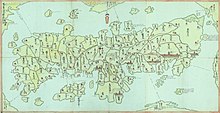Kumamoto Domain
| Kumamoto Domain 熊本藩 | |
|---|---|
| Domain of Japan | |
| 1587–1871 | |
| Capital | Kumamoto Castle |
| • Type | Daimyō |
| Historical era | Edo period |
• Established | 1587 |
• Disestablished | 1871 |
| Today part of | Kumamoto Prefecture |

The Kumamoto Domain (熊本藩, Kumamoto-han), also known as Higo Domain (肥後藩, Higo-han), was a Japanese domain of the Edo period. It was associated with Higo Province in modern-day Kumamoto Prefecture.[1]
In the han system, Kumamoto was a political and economic abstraction based on periodic cadastral surveys and projected agricultural yields.[2] In other words, the domain was defined in terms of kokudaka, not land area.[3] This was different from the feudalism of the West.
History[]
The domain was centered at the Kumamoto Castle in Kumamoto.
Under the Hosokawa, with an income of 540,000 koku, the Kumamoto domain was one of the largest in Kyushu, second only to the Satsuma Domain, and excluding the lands held by the Tokugawa and Matsudaira clans, the fourth-largest in Japan after the Kaga, Satsuma and Sendai domains.[4]
List of daimyōs[]
The hereditary daimyōs were head of the clan and head of the domain.
- Hosokawa clan, 1632–1871 (tozama; 540,000 koku)[6]
Genealogy[]
- Hosokawa Fujitaka (1534–1610)
- Tadaoki (1563–1645)
 I. Tadatoshi, 1st daimyō of Kumamoto (cr. 1632) (1586–1641; r. 1632–1641)
I. Tadatoshi, 1st daimyō of Kumamoto (cr. 1632) (1586–1641; r. 1632–1641)
 II. Mitsunao, 2nd daimyō of Kumamoto (1619–1650; r. 1641–1650)
II. Mitsunao, 2nd daimyō of Kumamoto (1619–1650; r. 1641–1650)
 III. Tsunatoshi, 3rd daimyō of Kumamoto (1641–1712; r. 1650–1712)
III. Tsunatoshi, 3rd daimyō of Kumamoto (1641–1712; r. 1650–1712)- Toshishige (1646–1687)
 IV. Nobunori, 4th daimyō of Kumamoto (1676–1732; r. 1712–1732)
IV. Nobunori, 4th daimyō of Kumamoto (1676–1732; r. 1712–1732)
 V. Munetaka, 5th daimyō of Kumamoto (1716–1747; r. 1732–1747)
V. Munetaka, 5th daimyō of Kumamoto (1716–1747; r. 1732–1747) VI. Shigekata, 6th daimyō of Kumamoto (1721–1785; r. 1747–1785)
VI. Shigekata, 6th daimyō of Kumamoto (1721–1785; r. 1747–1785)
 VII. Harutoshi, 7th daimyō of Kumamoto (1758–1787; r. 1785–1787)
VII. Harutoshi, 7th daimyō of Kumamoto (1758–1787; r. 1785–1787)
- Tatsutaka (1615–1645)
- Yukitaka, 1st daimyō of Udo (1637–1690)
- Aritaka, 2nd daimyō of Udo (1676–1733)
- Okinari, 3rd daimyō of Udo (1699–1737)
- Okinori, 5th daimyō of Udo (1723–1785)
 VIII. Narishige, 6th daimyō of Udo, 8th daimyō of Kumamoto (1755–1835; r. 1787–1810)
VIII. Narishige, 6th daimyō of Udo, 8th daimyō of Kumamoto (1755–1835; r. 1787–1810)
- Tatsuyuki, 7th daimyō of Udo (1784-1818)
 X. Narimori, 8th daimyō of Udo, 10th Lord of Kumamoto (1804–1860; r. 1826–1860)
X. Narimori, 8th daimyō of Udo, 10th Lord of Kumamoto (1804–1860; r. 1826–1860)
 XI.Yoshikuni, 11th daimyō of Kumamoto, 25th Hosokawa family head (1835–1876; r. 1860–1869. Governor of Kumamoto 1869–1871).
XI.Yoshikuni, 11th daimyō of Kumamoto, 25th Hosokawa family head (1835–1876; r. 1860–1869. Governor of Kumamoto 1869–1871).- Morihisa, 26th Hosokawa family head, 1st Marquess (1839–1893; family head 1876–1893; 1st Marquess Hosokawa: 1884–1893)
- Morishige, 27th Hosokawa family head, 2nd Marquess (1868–1914; family head and 2nd Marquess 1893–1914)
- Morikei, 1st Baron Hosokawa (cr. 1896) (1882–1898)
- Moritatsu, 28th Hosokawa family head, 3rd Marquess, 2nd Baron (1883–1970; 2nd Baron Hosokawa 1898, 14th Hosokawa family head 1914–1970, 3rd Marquess 1914–1947)
 IX. Naritatsu, 9th daimyō of Kumamoto (1788–1826; r. 1810–1826)
IX. Naritatsu, 9th daimyō of Kumamoto (1788–1826; r. 1810–1826)
- Tatsuyuki, 7th daimyō of Udo (1784-1818)
- Okinori, 5th daimyō of Udo (1723–1785)
- Okinari, 3rd daimyō of Udo (1699–1737)
- Aritaka, 2nd daimyō of Udo (1676–1733)
- Yukitaka, 1st daimyō of Udo (1637–1690)
- Tadaoki (1563–1645)
See also[]
- List of Han
- Abolition of the han system
References[]

- ^ "HIgo Province" at JapaneseCastleExplorer.com; retrieved 2013-5-24.
- ^ Mass, Jeffrey P. and William B. Hauser. (1987). The Bakufu in Japanese History, p. 150.
- ^ Elison, George and Bardwell L. Smith (1987). Warlords, Artists, & Commoners: Japan in the Sixteenth Century, p. 18.
- ^ Totman, Conrad. (1993). Early Modern Japan, p. 119.
- ^ Jump up to: a b c Papinot, Jacques Edmond Joseph. (1906). Dictionnaire d’histoire et de géographie du Japon; Papinot, (2003). "Katō" at Nobiliare du Japon, p. 20; retrieved 2013-5-24.
- ^ Jump up to: a b c Papinot, (2003). "Katō" at Nobiliare du Japon, p. 12; retrieved 2013-5-24.
- ^ Genealogy
External links[]
![]() Media related to Kumamoto Domain at Wikimedia Commons
Media related to Kumamoto Domain at Wikimedia Commons
- States and territories established in 1587
- States and territories disestablished in 1871
- Domains of Japan
- Higo-Hosokawa clan